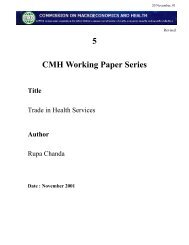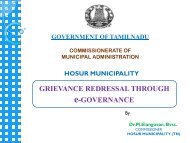prevention and control of non-communicable diseases - icrier
prevention and control of non-communicable diseases - icrier
prevention and control of non-communicable diseases - icrier
You also want an ePaper? Increase the reach of your titles
YUMPU automatically turns print PDFs into web optimized ePapers that Google loves.
Introduction<br />
The second half <strong>of</strong> the twentieth century witnessed major health transitions in the<br />
world, propelled by socio-economic <strong>and</strong> technological changes which pr<strong>of</strong>oundly altered<br />
life expectancy <strong>and</strong> ways <strong>of</strong> living while creating an unprecedented human capacity to<br />
use science to both prolong <strong>and</strong> enhance life. Among these health transitions, the most<br />
globally pervasive change has been the rising burden <strong>of</strong> <strong>non</strong>-<strong>communicable</strong> <strong>diseases</strong><br />
(NCDs). Epidemics <strong>of</strong> <strong>non</strong>-<strong>communicable</strong> <strong>diseases</strong> (NCD) are presently emerging or<br />
accelerating in most developing countries (Murray <strong>and</strong> Lopez 1996). Even as infections<br />
<strong>and</strong> nutritional deficiencies are receding as leading contributors to death <strong>and</strong> disability,<br />
cardiovascular <strong>diseases</strong> (CVDs), cancers, diabetes, neuropsychiatric ailments, <strong>and</strong> other<br />
chronic <strong>diseases</strong> are becoming major contributors to the burden <strong>of</strong> disease. India too<br />
illustrates this health transition, which positions NCDs as a major public health challenge<br />
<strong>of</strong> growing magnitude in the twenty-first century.<br />
As India experiences a rapid health transition, the mismatch between health care<br />
needs <strong>and</strong> resources is widened by an exp<strong>and</strong>ed list <strong>of</strong> health conditions that vie for<br />
attention from policy-makers <strong>and</strong> public health action while posting competing claims for<br />
clinical care. The complexities are compounded when policy has to prioritise on the<br />
basis <strong>of</strong> disease burdens, cost-effectiveness, <strong>and</strong> equity while the delivery systems have<br />
to simultaneously cope with the transformative pressures <strong>of</strong> economic restructuring <strong>and</strong><br />
health care reforms. The challenges <strong>of</strong> providing acute <strong>and</strong> chronic care for NCDs in such<br />
settings are immense, yet the imperatives <strong>of</strong> proper planning <strong>and</strong> performance for<br />
delivering such care become increasingly urgent as health transition rapidly rewrites a<br />
new agenda for health care in the India.<br />
Existing health systems need to be reorganised, reoriented, <strong>and</strong> recruited to<br />
deliver the exp<strong>and</strong>ed m<strong>and</strong>ate <strong>of</strong> health care involving the <strong>prevention</strong>, surveillance <strong>and</strong><br />
management <strong>of</strong> chronic <strong>diseases</strong>. The sustained nature <strong>of</strong> preventive interventions,<br />
required over many years, as well as the growing dem<strong>and</strong> for acute <strong>and</strong> chronic care <strong>of</strong><br />
NCDs will need to be accommodated into the agenda <strong>of</strong> primary <strong>and</strong> secondary health<br />
1

















